July 17, 2025 – TheNewswire - Rockport, Ontario– New Age Metals Inc. (TSX.V: NAM | OTCQB: NMTLF | FSE: P7J) (“NAM” or the “Company”) is pleased to announce completion of its Phase 1 field reconnaissance exploration program on its Sb-Au properties located in the Gander area of central Newfoundland and in the St. Alban’s area of south-central Newfoundland (for more information, see Company’s recent press releases – click here).
Highlights of the Phase 1 Field Recon Work
-
A total of 286 rock samples (assays pending) were collected from mineralized, deformed, and altered outcrops and float boulders across multiple mineral licenses, including Citadel, Rampart, Redoubt, Fort, Sentinel, Fastness, Palisade, and Sentry;
-
Abundant sulfide-bearing quartz veins with widespread pyrrhotite, pyrite, chalcopyrite, and arsenopyrite were identified, particularly in the St. Alban’s region. Elevated levels of Sb, Cu, Pb, Zn, and As were detected using a handheld pXRF device;
-
A due diligence site visit was conducted on the adjacent Antimony Ridge Property, confirming the presence of high-grade antimony–quartz veins in outcrop. This led to the recent option agreement, further consolidating NAM’s land position along the potentially emerging Sb-Au trend in the St. Alban’s region (see NAM press release dated July 7, 2025); and NAM’s technical team eagerly awaits the laboratory assay results from Phase 1 samples. When received, a comprehensive review will be undertaken to prioritize and guide the anticipated Phase 2 exploration program.
Antimony, a critical metal: China, the world’s largest producer/refiner severely restricted antimony exports in December 2024, including a ban on shipments to the US, sending Antimony price to more than $60,000 per metric tonne, which more than quadrupled over the past year. China's recent antimony export ban created a supply shock for the strategic metal.
Harry Barr, NAM Chairman and CEO states, “The initial field results from NAM's Sb-Au properties in the Gander and St. Alban's areas validate our exploration strategy and highlight the region's potential to host multiple types of mineralization. The field observations reveal a compelling combination of prospective stratigraphy, structural complexity, confirmed high-grade antimony–quartz veins, and widespread sulfide-bearing quartz systems, all of which underscore the strength and potential of these targets. Advancing this work aligns well with the current historically high gold and antimony prices. We look forward to receiving assay data for these highly prospective Sb-Au properties and continuing to build on their significant potential.”
Phase 1 Field Program Observations
The Phase 1 program successfully covered large areas of NAM’s Sb-Au properties as part of a first-pass reconnaissance exploration effort. A total of 286 rock samples were collected and 63 geopoints mapped, effectively documenting lithologies, mineralogy, alteration, and structural features across the traversed areas. The Company’s technical consultants from Axiom Group validated the majority of historical mineral occurrences documented in the Newfoundland government’s Mineral Occurrence Database (“MODS”)1 and identified several new, promising occurrences.
Central Sb-Au Properties (Beaver Brook Antimony Mine Area – Near Gander, NL)
In the Beaver Brook area, the team successfully accessed and assessed all claim blocks, except for the Garrison block. Despite limited outcrop exposure, numerous encouraging boulders and float samples were collected. Given the close proximity to the Beaver Brook Antimony Mine and New Found Gold’s Queensway South Gold Project, these results are highly promising. NAM’s technical team is now undertaking a thorough review of all field data to develop a refined conceptual model and an exploration strategy tailored for these properties.
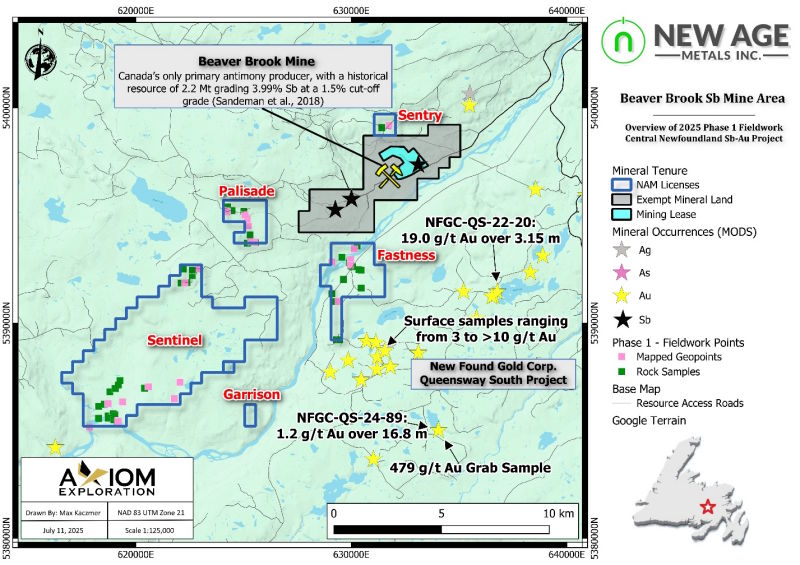 Figure 1. Sampled locations and mapped geopoints in the Beaver Brook Antimony Mine area near Gander, Newfoundland.
Figure 1. Sampled locations and mapped geopoints in the Beaver Brook Antimony Mine area near Gander, Newfoundland.
To view an enhanced version of this Figure, please visit: Click Here
South Central Sb-Au Properties (St Alban’s area properties near Bay D’Espoir, Newfoundland)
The St. Alban’s properties revealed abundant sulfide-bearing quartz veins, characterized by widespread pyrrhotite and pyrite, and veins that host chalcopyrite and arsenopyrite. The field crew, led by Axiom Group, also evaluated the recently optioned Antimony Ridge property (see NAM’s July 7, 2025 press release). Although exposure was limited, the team confirmed the presence of antimony–quartz veins over an exposed strike length of approximately 400 metres. Localized zones contained at least three foliation-parallel quartz-stibnite veins ranging from 10 to 30 cm in thickness (Figures 3A and 3B).
Notably, this occurrence has never been systematically explored or drill-tested to date. Additionally, in the southeast portion of the Antimony Ridge property, many (>10) pieces of massive stibnite float were discovered (Figure 3C), likely derived from a nearby local source.
Minimal time was spent on the Fort property; however, historical galena occurrences hosted in meta-psammitic rocks of the Baie d’Espoir Group were confirmed, along with several newly identified, undocumented occurrences of galena within broad silicified zones.
At Redoubt, the teams were highly encouraged by oxidized cliffside outcrops displaying large-scale faulting. Numerous sampling stations yielded anomalous arsenic readings on the pXRF, likely derived from arsenopyrite.
On the Rampart property, a new zinc occurrence was mapped, spatially associated with strongly deformed (isoclinally folded) rocks of the Little Passage Gneiss Group. This occurrence suggests potential polymetallic mineralization and opens new target areas for follow-up exploration.
These findings align well with recent Newfoundland Geological Survey studies2, which documented structurally controlled antimony–arsenic–gold mineralization within the Baie d’Espoir Group of the St. Alban’s Region and highlighted the importance of structural complexity and repeated fluid flow events in localizing mineralization.
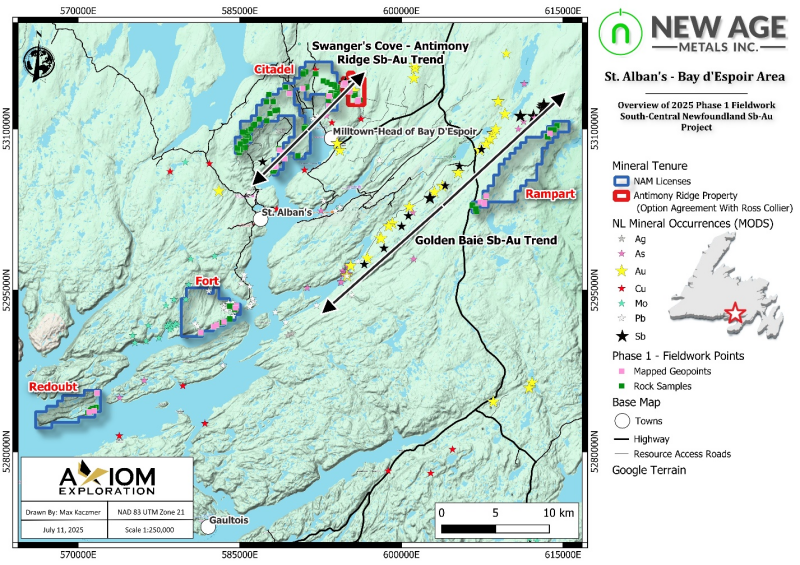 Figure 2. Sampled locations and mapped geopoints on the St Alban’s area properties near Bay D’Espoir, Newfoundland.
Figure 2. Sampled locations and mapped geopoints on the St Alban’s area properties near Bay D’Espoir, Newfoundland.
To view an enhanced version of this Figure, please visit: Click Here
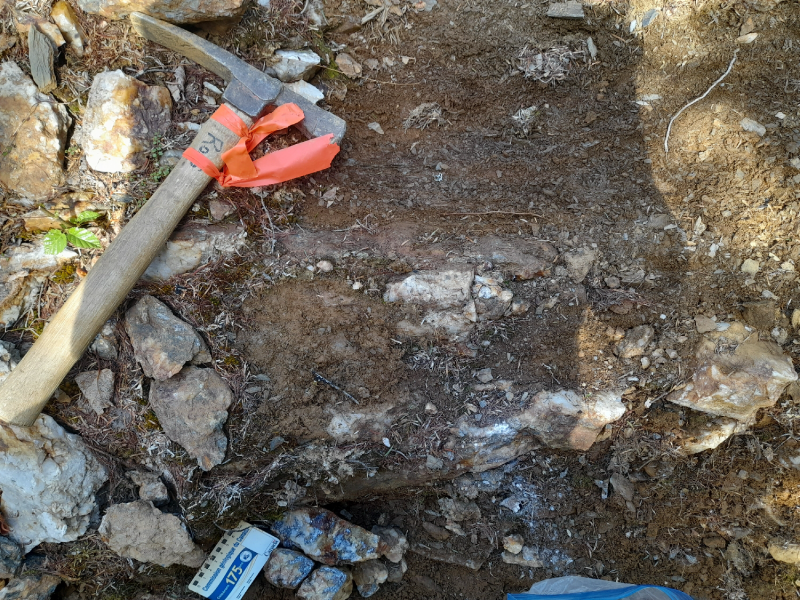 Figure 3A. Quartz-stibnite vein in outcrop at Antimony Ridge. Hammer oriented north
Figure 3A. Quartz-stibnite vein in outcrop at Antimony Ridge. Hammer oriented north
To view an enhanced version of this photograph, please visit: Click Here
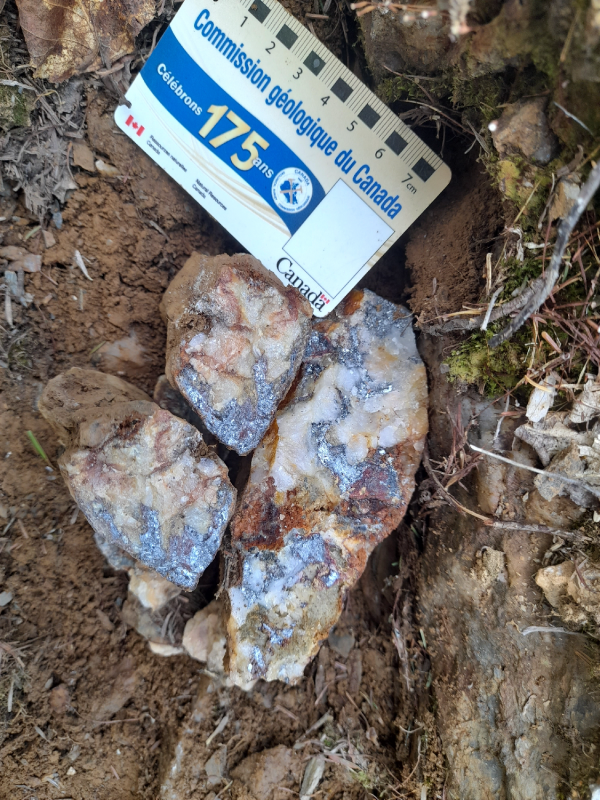 Figure 3B. Stilbite-quartz sample from Antimony Ridge.
Figure 3B. Stilbite-quartz sample from Antimony Ridge.
To view an enhanced version of this photograph, please visit: Click Here
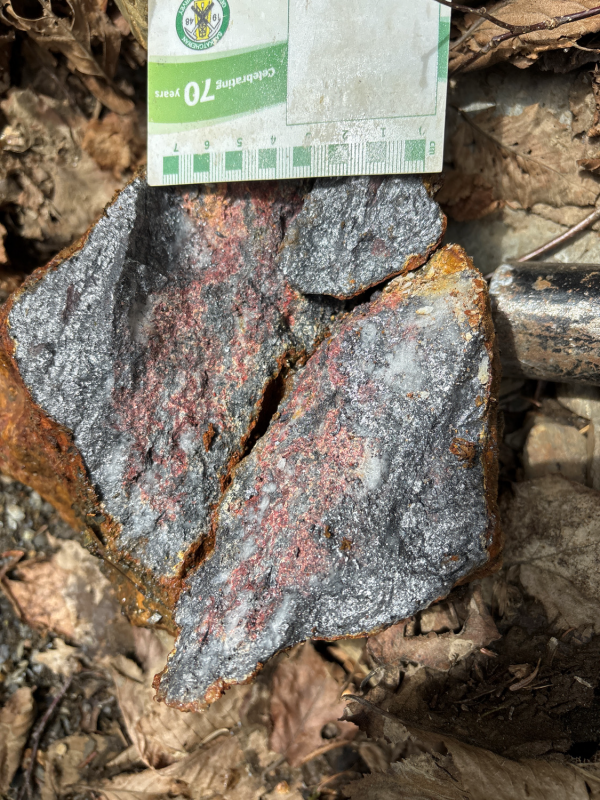 Figure 3C. Massive stibnite-quartz-kermesite float sample from southeast of Antimony Ridge.
Figure 3C. Massive stibnite-quartz-kermesite float sample from southeast of Antimony Ridge.
To view an enhanced version of this photograph, please visit: Click Here
Cautionary Note on pXRF Data
Grab samples were analyzed on-site using a Thermo Scientific™ Niton™ XL5 Plus handheld XRF, operated by Axiom Group staff. The portable X-Ray Fluorescence (“pXRF”) data is preliminary and intended primarily as a rapid screening tool to assist with field target prioritization and mineral identification during early-stage exploration. pXRF data does not represent definitive geochemical results for the entire rock mass and should only be considered indicative pending laboratory assays.
Antimony and Gold Markets Commentary
Reuters reported on June 17th, 20253 that China severely restricted antimony exports, including a ban on shipments to the US, sending Antimony price to more than $60,000 per metric tonne, having more than quadrupled over the past year. As a critical metal, antimony's market dynamics are influenced by its applications in various industries and geopolitical factors. China's recent antimony export ban created a supply shock for the strategic metal. Approximately 70% of antimony is produced or refined in China.
Spot gold prices have traded as high as US$3,500 per ounce, likely driven by heightened global uncertainties and increased demand from institutional and retail investors. Central banks have continued their robust gold purchasing in 2025, adding 244 tonnes to their global reserves in Q1 and maintaining a strong pace into Q2, putting them on track for approximately 1,000 tonnes of purchases for the year. This sustained buying action underscores gold's role as a strategic asset amid economic instability and inflation concerns. Retail investors and family offices have also increased their gold holdings, seeking to hedge against market volatility. In Q1 2025, gold ETF inflows surged by 1,114% quarter-over-quarter, reaching 226.5 tonnes. Despite some outflows in May, year-to-date ETF inflows remain strong at over 322 tonnes, reflecting a continued revival in retail appetite for gold.
The convergence of these factors highlights the strategic importance of antimony and gold antimony on the current global economic landscape.
NAM’s Strategic Antimony-Gold Land Position
NAM’s properties in Newfoundland amount to approximately 19,800 hectares in
11 non-contiguous properties. Six of these properties are in the St. Alban’s area, along Canstar’s Swanger and Little River mineralized trends (Figures 4 and 5). The remaining five properties are strategically located along the same geological trend as the past-producing Beaver Brook Antimony Mine and in proximity to New Found Gold’s Queensway South Gold Project (Figures 4 and 6).
Qualified Person
Dr. William Stone, P.Geo. and a Qualified Person for the purposes of National Instrument 43-101 Standards of Disclosure for Mineral Projects and a consultant to NAM, has reviewed and approved the scientific and technical disclosure in this press release.
The Qualified Person has not completed sufficient work to verify the historical information on the neighbouring properties. Nevertheless, the Qualified Person considers that drilling and analytical results were completed to industry standard practices. The reader is cautioned that mineral occurrences, prospects and deposits on neighbouring properties are not necessarily indicative of mineralization on the Company’s properties. This information may provide an indication of the exploration potential of the Properties, but might not be representative of exploration results.
About NAM’s PGE Division
New Age Metals is a junior mineral exploration and development company focused on the discovery, exploration, and development of critical/green metal projects in North America. The Company has three critical metal divisions: a Platinum Group Element division, a Lithium/Rare Element division, and a Gold-Antimony Division.
The PGE Division includes the 100% owned, multi-million-ounce, district-scale River Valley Project, one of North America’s largest undeveloped Platinum Group Element Projects, situated 100 km by road east of Sudbury, Ontario. In addition to River Valley, NAM owns 100% of the Genesis PGE-Cu-Ni Property in Alaska.
About NAM’s Lithium Division
The Company’s Lithium Division is one of the largest mineral claim holders in the Winnipeg River Pegmatite Field, where the Company is exploring for hard rock lithium and various rare elements such as tantalum, rubidium, and cesium. NAM is developing its lithium division in conjunction with its Farm-in/Joint Venture agreement with Mineral Resources Ltd. (“MinRes”), one of the world’s largest lithium producers. A minimum budget to maintain the Projects has been approved by Mineral Resources Ltd for May 2025 to April 2026. The Companies agreed to the minimum budget due to current lithium pricing and forest fire dangers in the immediate area
In April 2024, a $1.5M NSERC Alliance grant was awarded to a collaboration led by the University of Manitoba (Drs. Fayek and Camacho), with academic partners from Lakehead University (Dr. Hollings) and industry partners including New Age Metals and Grid Metals. This research is focused on advancing Canada’s critical metals sector, with New Age Metals’ portion targeting its Bird River lithium properties. Approximately $107,000 of work is planned on New Age’s properties in 2025. The early work will, subject to precautions for regional wildfire, will include core sampling and field visits starting this summer. The project will likely extend beyond the original 3-year term, due to its delayed start.
New Age Metals Inc. is supporting a successful $180K Mitacs research grant, awarded in 2023, through its $90K contribution (already accounted for and paid under the Mineral Resources joint venture). This academic partnership with the University of New Brunswick and the University of British Columbia is focused on understanding the origin and controls of lithium pegmatite mineralization in the Cat Lake–Winnipeg River field. Fieldwork for the MSc. thesis has been completed, while the post-doctoral phase is ongoing at UNB.
This collaboration provides access to top-tier scientific expertise and equipment, significantly reducing analysis costs and adding long-term value to the project.
Management is currently aggressively seeking new mineral acquisition opportunities.
Our philosophy is to be a project generator with the objective of optioning our projects with major and mid-tier mining companies through to production.
The Company is actively seeking an option/joint venture partner for its River Valley Palladium Project and its road-accessible Genesis PGE-Cu-Ni Property in Alaska.
Investors are welcome to visit the New Age Metals website at www.newagemetals.com where they can review the company and its corporate activities. Any questions or comments can be directed to This email address is being protected from spambots. You need JavaScript enabled to view it. or Harry Barr at This email address is being protected from spambots. You need JavaScript enabled to view it. or Farid Mammadov at This email address is being protected from spambots. You need JavaScript enabled to view it. or call 613 659 2773.
Opt-in List
If you have not done so already, we encourage you to sign up on our website (www.newagemetals.com) to receive our updated news.
On behalf of the Board of Directors
“Harry Barr”
Harry G. Barr
Chairman and CEO
Neither the TSX Venture Exchange nor its Regulation Services Provider (as that term is defined in the policies of the TSX Venture Exchange) accepts responsibility for the adequacy or accuracy of this release.
Cautionary Note Regarding Forward Looking Statements: This release contains forward-looking statements that involve risks and uncertainties. These statements may differ materially from actual future events or results and are based on current expectations or beliefs. For this purpose, statements of historical fact may be deemed to be forward-looking statements. In addition, forward-looking statements include statements in which the Company uses words such as “continue”, “efforts”, “expect”, “believe”, “anticipate”, “confident”, “intend”, “strategy”, “plan”, “will”, “estimate”, “project”, “goal”, “target”, “prospects”, “optimistic” or similar expressions. These statements by their nature involve risks and uncertainties, and actual results may differ materially depending on a variety of important factors, including, among others, the Company’s ability and continuation of efforts to timely and completely make available adequate current public information, additional or different regulatory and legal requirements and restrictions that may be imposed, and other factors as may be discussed in the documents filed by the Company on SEDAR (www.sedar.com), including the most recent reports that identify important risk factors that could cause actual results to differ from those contained in the forward-looking statements. The Company does not undertake any obligation to review or confirm analysts’ expectations or estimates or to release publicly any revisions to any forward-looking statements to reflect events or circumstances after the date hereof or to reflect the occurrence of unanticipated events. Investors should not place undue reliance on forward-looking statements.
1 Newfoundland & Labrador Geological Survey. Mineral Occurrence Database System (MODS). Government of Newfoundland and Labrador. Available at: https://gis.geosurv.gov.nl.ca/mods/ (Accessed July 2025).
2 Westhues, A., 2017. Updated Geology of the St. Alban’s Map Area (NTS 1M/13), Dunnage and Gander Zones. Newfoundland and Labrador Department of Natural Resources, Geological Survey, Current Research Report 17-1, pages 87–103.


